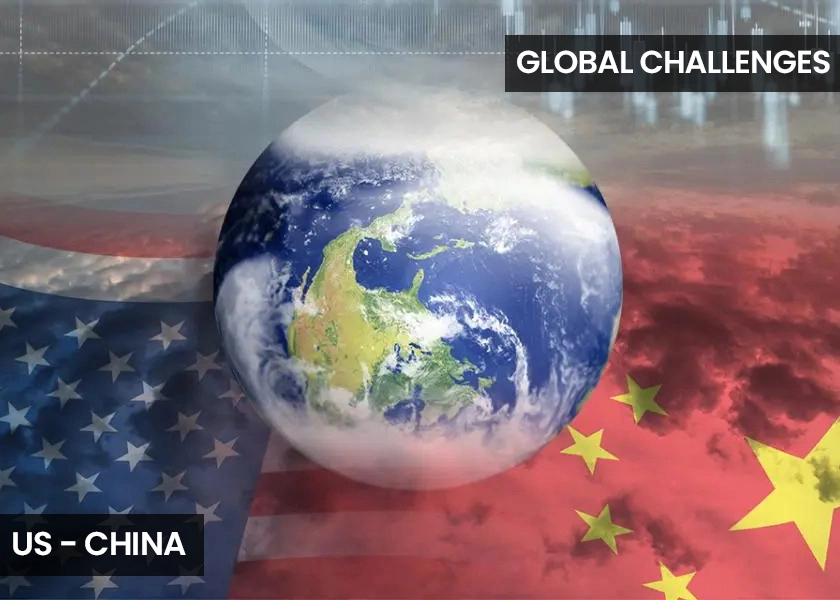Introduction of USA China International Polices
Whether we consider the connection between the American states and the People’s Republic of China in terms of domestic history or overall politics, it is undeniably multi-dimensional and extremely nuanced. As they are the most successful economies and mightiest geopolitical powers on the planet, the decisions and relationships here create a new world model. It also impacts global trade, security, and progress in general. The USA and China international policies are the most complex relationship ever.
These two giants have a rather dynamic relationship that could be described as a balance in which they try to act together, be inexpensive, and at the same time meet to achieve what they deem needed at the time. This is a constant tug-of-war between states due to the varying philosophies and planned goals that they pursue for themselves, along with the global issues that they more and more meet together. USA-and-China-International-Policies
Historical Context USA-and-China-International-Policies
American-Chinese relations have changed from cooperation against common enemies to causing conflicts most of the time, including their major clashes during the Cold War when they competed against each other. The substantial milestones of the Union between the two nations are generally related with the early 20th century. The United States and China recovered diplomatic relations on international policies, signaling the beginning of a new era. < USA-and-China-International-Policies
To start with, it was economic facts that became the main motivation, but then after it developed itself into the complicated interlope of economic dependence and geopolitical rivalry.
Economic Interdependence USA and China International Policies
The fertile trade relations between the United States of America and China have been developing gradually over the past four decades. Nowadays, China is a producing powerhouse, referring to the fact that the US is a user market. Firstly, the economy has bad relationships, particularly with regard to trade imbalances, intellectual property rights, and market access. USA-and-China-International-Policies
The ongoing “trade war” (forced by the Trump management and defined through tariffs and trade barriers) shed light on the vulnerability of interconnection in this economic order and acted as a clear presentation of broader planned concerns associated with China’s future success as a substantial economic rival.
Strategic Rivalry USA-and-China-International-Policies
For a long time, China and the United States of America have been involved in a strategic struggle for management in several different kinds of regions, for instance, the Asia-Pacific region, Africa, and Latin America. This primary concern extends well beyond economic thoughts. The U.S. indeed holds the position of the principal military power in the Asia-Pacific region thanks to its widespread relations within the alliance’s and bases’ networks. Yet, the expansion of China’s army with its modern arm, respectively, and territorial aggression in the South China Sea are the greatest threats to the current historical state of affairs. USA-and-China-International-Policies
Moreover, besides the Belt and Road Initiative of China, which is now becoming famous under the name BRI and is a tremendous infrastructural project that covers many continents, other countries, for example, the USA, view it as a deliberate Chinese strategy for spreading the influence and countering the hegemonic position of the USA.
Ideological Clash USA-and-China-International-Policies
On the contrary, the United States of America and China are antagonistic, making the existing tensions between the two countries even more troublesome. While the United States of America sings praises to liberal democracy, individual liberties, and the protection of human rights, China upholds an authoritarian regime, state-led capitalism, and intervention in internal affairs policy. USA-and-China-International-Policies
The clash of the two sides` views will be clear in discussing their opinions on matters like Taiwan, Hong Kong, and Xinjiang. The United States of America stands alone with democratic values, and so does China, which disputes any interventions from external sources. Thus, there is a negative relationship between USA and China international policies. USA-and-China-International-Policies
Global Challenges between USA and China
China and the USA agree on the need to cooperate humanly with the USA to solve global problems regarding climate change, nuclear proliferation, and epidemics, even though they have significant political differences with them.
In many cases, government actions of the braces of two nations lying together in the struggle towards the same aims can be noted, for instance, the Paris Agreement on climate change as well as the Iran nuclear deal. These two problems also form the association aspect. Contrarily, geopolitics is usually what prevents real collaboration, which is showed, for instance, by the Russia-US tensions over Iran sanctions and the Trump administration’s distrust of multilateralism. USA-and-China-International-Policies
The Biden Administration’s Approach
The election of Joe Biden as president brought with it the hope of a rather beneficial and indeed practical policy regarding the USA and China’s international policies. On the one hand, the Biden administration has shown its readiness to work together with China in areas where both parties’ interests agree, such as decrease climate change and solving global health crises. USA-and-China-International-Policies
The two nations recognize and compete on a planned level. However, the state sticks to its democratic principles and human rights values with regard to Taiwan and China’s behavior in Xinjiang and the Autonomous Region. The plight of the Uyghur and native Hong Kongers has upset the hearts of US politicians. Unlike the Soviets, their engagement was more nuanced and based on a firm stance on human rights.
In the Wallet chapter that follows, so many things, like national politics, economic trends, technological advances, and geopolitical events, can affect the manner in which the USA and China will be appealing each other in this relationship. The fragile balance between the two powers, who have different objectives, calls for skilled diplomats’ and futurists’ vision and resolve to meet halfway in spite of the conflict of interests. Meanwhile, a total conflict is an inability; it is, however, a definitive prospect.
Conclusion USA-and-China-International-Policies
Finally, the communication between the United States and China reveals a complex connection of together helpful teamwork, equal challenge, and unavoidable confrontation. A review of the diverse qualities that make up their relations shows such factors as economic importation, strategic rivalry, ideological differences, and environmental problems. In the context of being global forces within themselves, they will be the ones that will try and cope with this problem, and this will always have serious consequences for world affairs and the structure of global matter. USA-and-China-International-Policies






